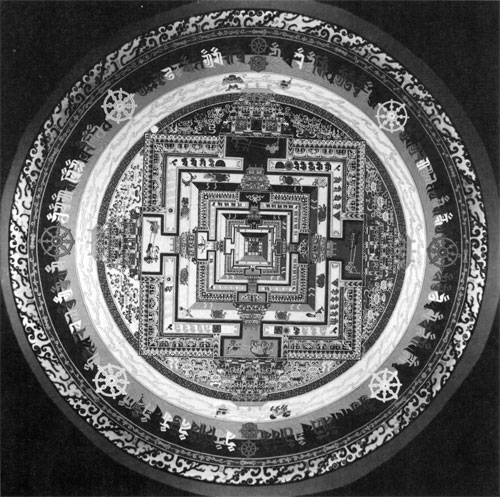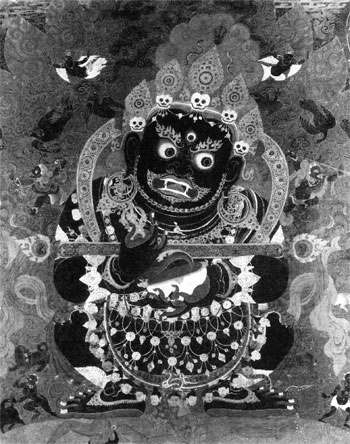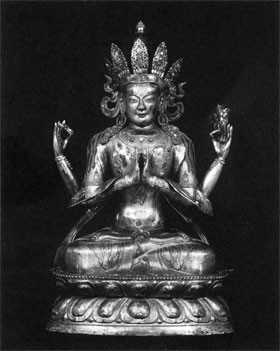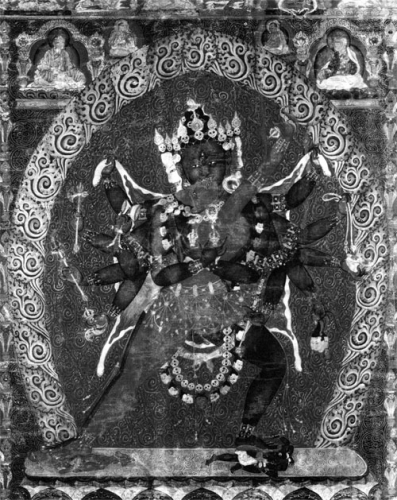Strains of long silver trumpets and the deepthroated chanting of monks greeted the arrival of His Holiness the Fourteenth Dalai Lama, Tenzin Gyatso, at the Asian Art Museum of San Francisco in April. The religious and temporal leader of Tibet’s exiled Buddhist population had come to grant a special blessing, initiating the creation of a large-scale sand mandala for the opening of “Wisdom and Compassion: The Sacred Art of Tibet.” This stunning exhibition of Tibetan paintings, sculpture, and tapestries dating from 900 to 1900 C.E. has been assembled from prominent museums and private collections in North America, Europe, and the Soviet Union. Notably, none of the pieces were borrowed from either institutional or official sources in the People’s Republic of China, to which Tibet has been politically bound for more than thirty years. The unaccustomed pageantry and the venerable presence of the Dalai Lama signaled an exhibition that was intended to be distinctly different from the usual objective presentation of works of art in a “neutral” museum space.

While public recognition of the value of Tibet’s culture is belated, this exhibition seeks to reinstate a certain spiritual dimension to rare treasures of fine art that have been forcibly ejected and poignantly cut off from their own spiritual and cultural setting. Aiming to illuminate the dramatic beauty and historical importance of these works from the perspective of their symbolic significance, the curators combined didactic, spiritual, and aesthetic objectives, demonstrating the art’s function within a sacred context. These goals were furthered by informative wall labels in each gallery and a thorough, beautifully illustrated catalogue with essays by an international group of scholars, including Marilyn M. Rhie and Robert A. F. Thurman, which elucidated the iconographic details and provided an instructive backdrop of stylistic and religious developments in Tibet’s 1,300-year Buddhist history.
The exhibition was conceived as an experiential pilgrimage predicated on the symbolism of the mandala, a circumscribed ritual area, sacred circle, or palace. The particular mandala used here is the Kalachakra, or Wheel of Time. The theme and the arrangements of individual pieces within each room of the exhibit supposedly replicate the structure of such a “cosmic map.” The intention of the map is to lead the viewer through successive phases of Buddhist ritual and symbolism (pointing out different waves of historical development along the way), while simultaneously prompting the viewer to shed the role of passive observer—to experience the art as a Tibetan believer or initiate might—in a more interactive, spontaneously devotional and meditative manner.
The Kalachakra mandala is seen as a square, jewel-bedecked palace, or mansion, denoting the self or microcosm, at whose center is the diamond throne, the seat of the deity or Buddha, as the focus of meditation. In addition, the throne refers to Mount Meru, the center of the universe in Hindu and Buddhist mythology. The palace is surrounded by five circular bands, or halls, representing various elements, aspects of psychological development, obstacles along the path, stages of consciousness, and so on.
The meditative and ritual practices of Vajrayana (or Tantric) Buddhism incorporate and rely upon the arts on many levels. Symbolic imagery is the basis for imaginative visualization, fostering the processes of self-transformation that are its goal and motivation.

Powerful, consciously designed imagery is intended to inspire the individual not only to seek eventual enlightenment but to look beyond the self in the here-and-now in order to identify with the entire universe and to extend enlightened principles into the thoughts and actions of daily life. The bewildering, complex mandala diagrams and the multitude of awesome, even terrifying or oddlooking deities are simply dramatic manifestations and embodiments of the two complementary aspects of liberated mind—wisdom and compassion, defined respectively in Buddhist terminology as the direct awareness of reality and as the natural expression of wisdom toward all beings. Together they give rise to the dynamic interplay that exists at the root of all Tantric symbolism. These two forces activate all the images and icons that deeply affect the psyche and so assist the practitioner to make profound mental, physical, and spiritual changes, which in turn convert negative energies—destructive emotions and psychological obstacles—into creative forces and actions benefiting others. This is inspirational imagery that leads through and beyond individual self, or ego, to an expansive, empowering awareness. The Buddhist conviction is that all beings are inherently buddhas and that our world is a potential mandala-paradise, if we can only recognize it as such.

At the Asian Art Museum, the attempt to align the layout of the exhibition with the symbolic content of the works shown was not readily apparent even to attentive viewers, since the museum’s limited available space did not lend itself to the idea. But neither did it completely detract from viewing or appreciating the exquisite thangka paintings and meticulously sculpted figures and objects as profoundly effective works of great artistry and spiritual power. The presence of several monks fabricating the sand mandala during the initial weeks and their activities in relation to it—which included a beginning consecration, daily chanting, and a ritual destruction on the closing day—not only drew intrigued crowds but did add a genuine sense of the sacred process and context to the exhibit.
Beyond these issues, there exists another broader dilemma: does the placement of sacred art inside a museum have a secularizing effect on the art? Or conversely, does it sanctify a secular institution? Are religious works of art divested of a measure of their significance through this isolation from their own culture, or are they imbued with some new or different kind of presence, due to the specialized aesthetic focus granted by the museum’s cultural position in Western society? Can the spiritual qualities of these pieces (as consecrated, ritually potent icons) survive the dislocation from their original Tibetan framework, or do they sacrifice something of their inherent power to the confines and neutrality of the museum?
Tibetan art objects were created within a specific cultural milieu, dedicated to serving the Buddhist faith by engaging the viewer in an active participation with symbolic imagery for the express purpose of leading the mind toward clarity, equanimity, inner bliss, and enlightenment. In the traditional Tibetan monastic temple, the artifacts in their lavish, magically evocative surroundings formed an integrated, iconographic whole. Whether in vast assembly or chanting halls or in small private chapels, the entire structure encouraged a mode of pilgrimage and fostered an attitude of wonder, awe, and meditative devotion. It is clear that certain factors would prevent a museum from completely duplicating the opulent, extravagant environment of the Tibetan temple interior. It seems that the exhibition’s organizers themselves were ambivalent. On the one hand, they aimed to invoke the sacred context, while on the other, they clearly wished to avoid simulating the monastic setting, as shown by their decision to exclude ethnic or cultural artifacts such as altar furnishings, fabric hangings, or ritual implements, which would have complemented the pieces chosen for display. Instead, they concentrated on what is traditionally considered to be the high art of painting and sculpture. There was a slight nod to textiles, with only three pieces shown; and although these were fine examples of applique, split-tapestry (kesi), and embroidery, nonetheless they were essentially reproductions of paintings in various fabric techniques. This constituted an imbalance that did not do justice to or truly reflect the exuberantly exotic clutter and glitter of media that typifies the Buddhist art of Tibet as it would appear in situ.

Divorced from its natural framework and habitual trappings, Tibetan sacred art seems to lose some degree of potency. The institutional setting does not exactly secularize the art, but it does filter out or tone down its bolder effects. Yet somehow this body of art manages to survive the cultural displacement with much of its significance and beauty intact. By virtue of its exceptional artistry and meaningfulness it still projects cogent messages, fascinating and attracting through its vibrancy as well as by means of the archetypal universality of its symbolic forms. Although not as redolent with atmosphere as when seen within a Tibetan temple, these consecrated images do temporarily spiritualize the museum environment, offering a vivid experience of the extraordinary, inspiring realities of mind, heart, and spirit that Tibetan sacred arts reveal.
Thank you for subscribing to Tricycle! As a nonprofit, we depend on readers like you to keep Buddhist teachings and practices widely available.